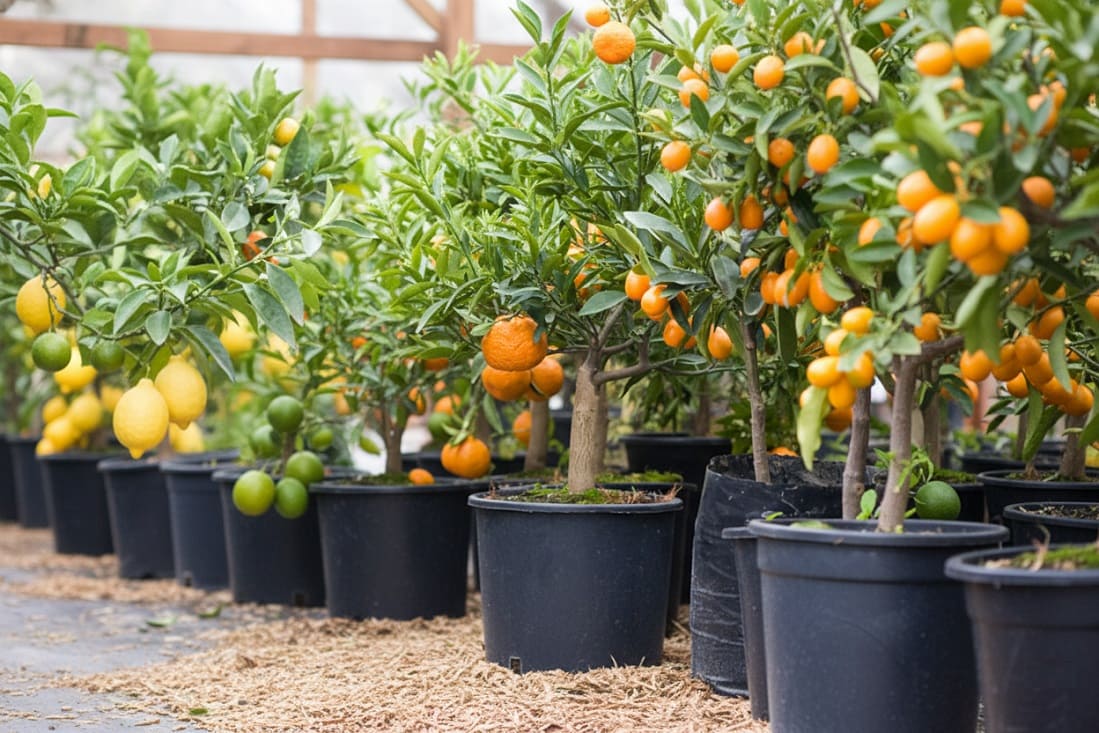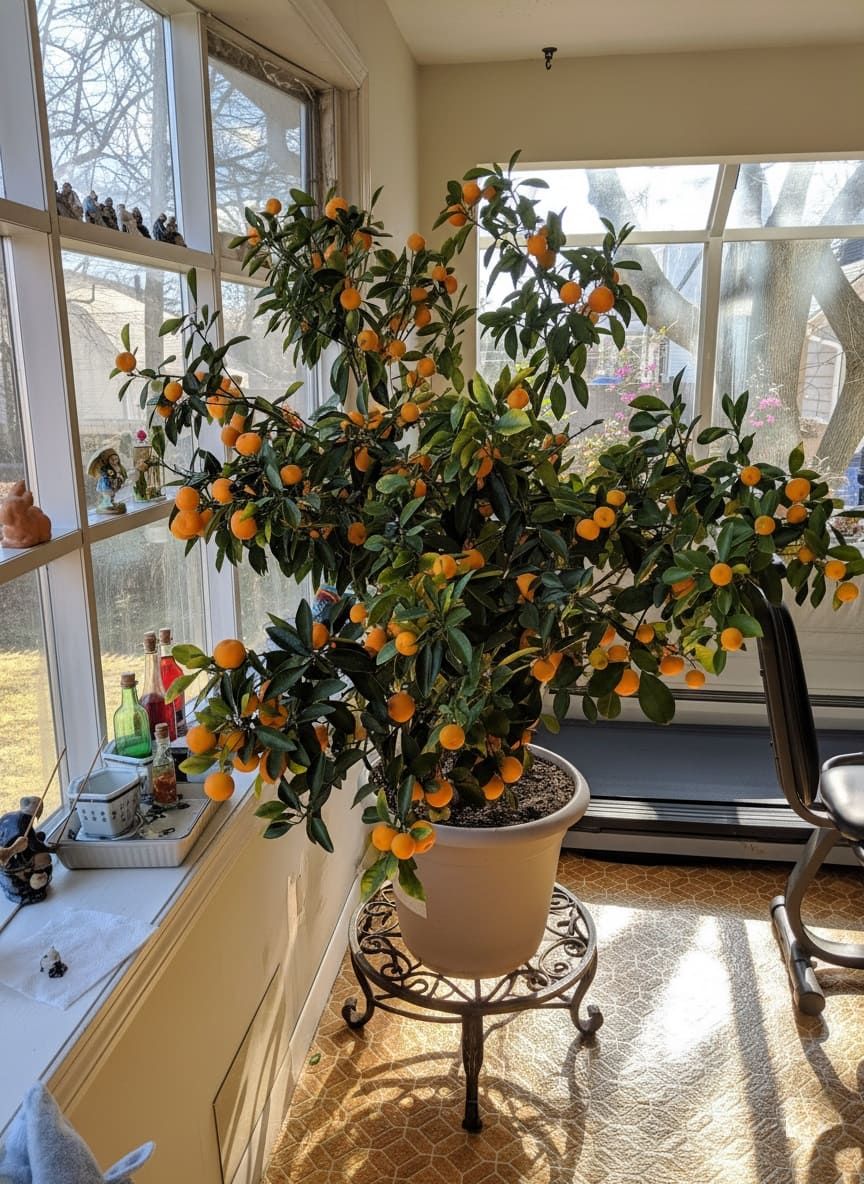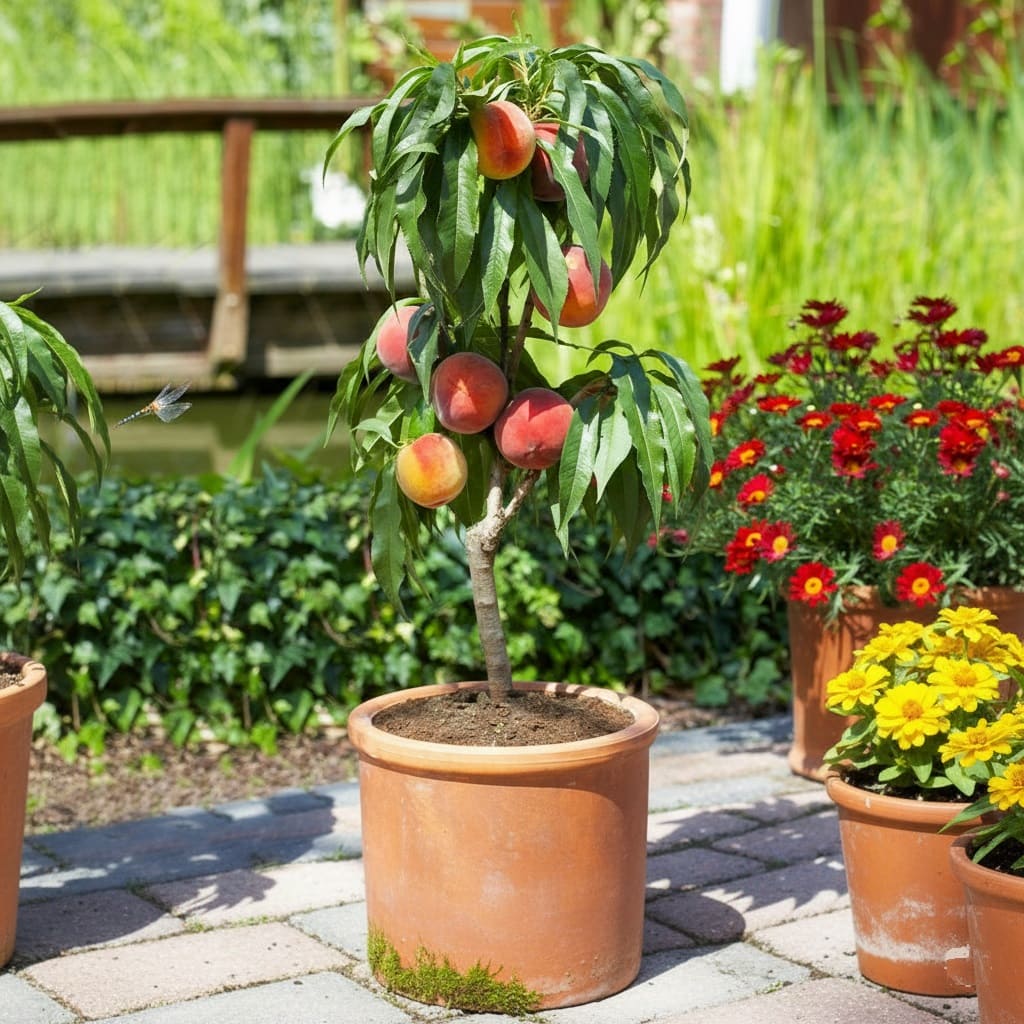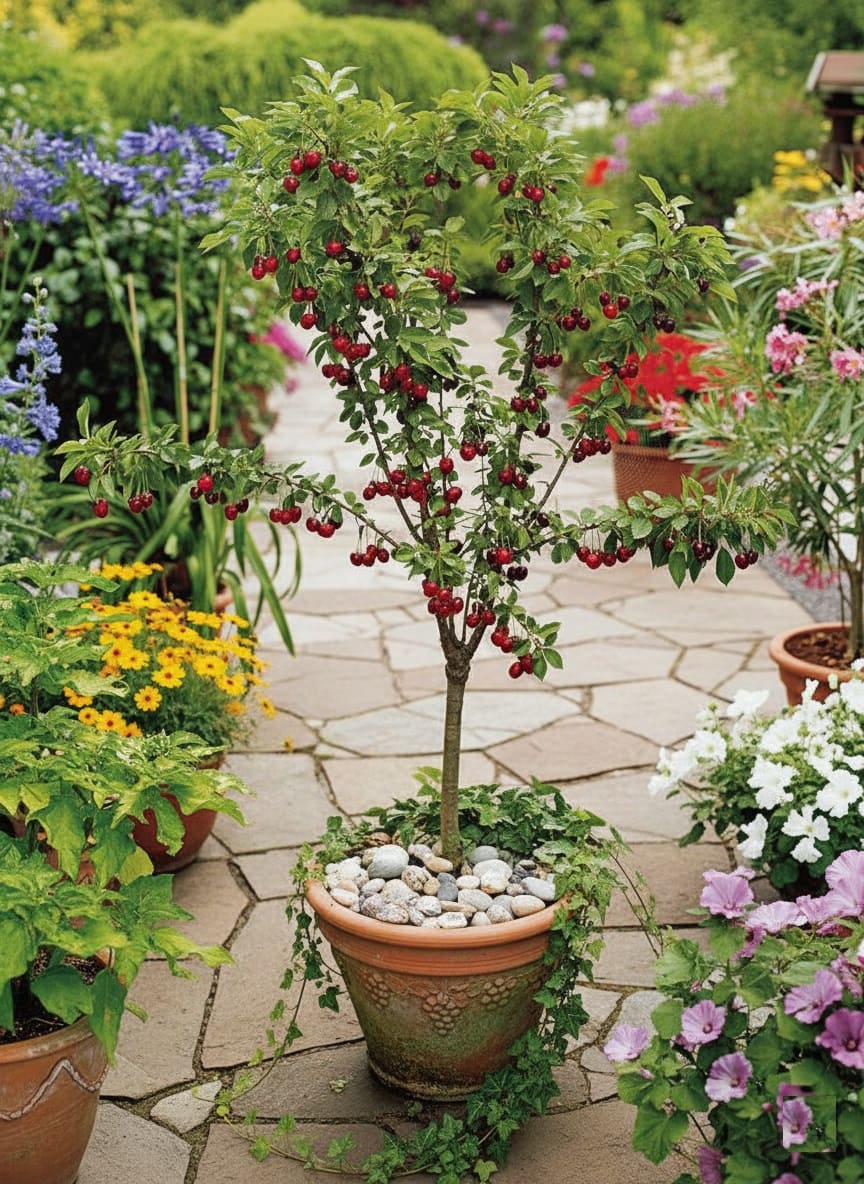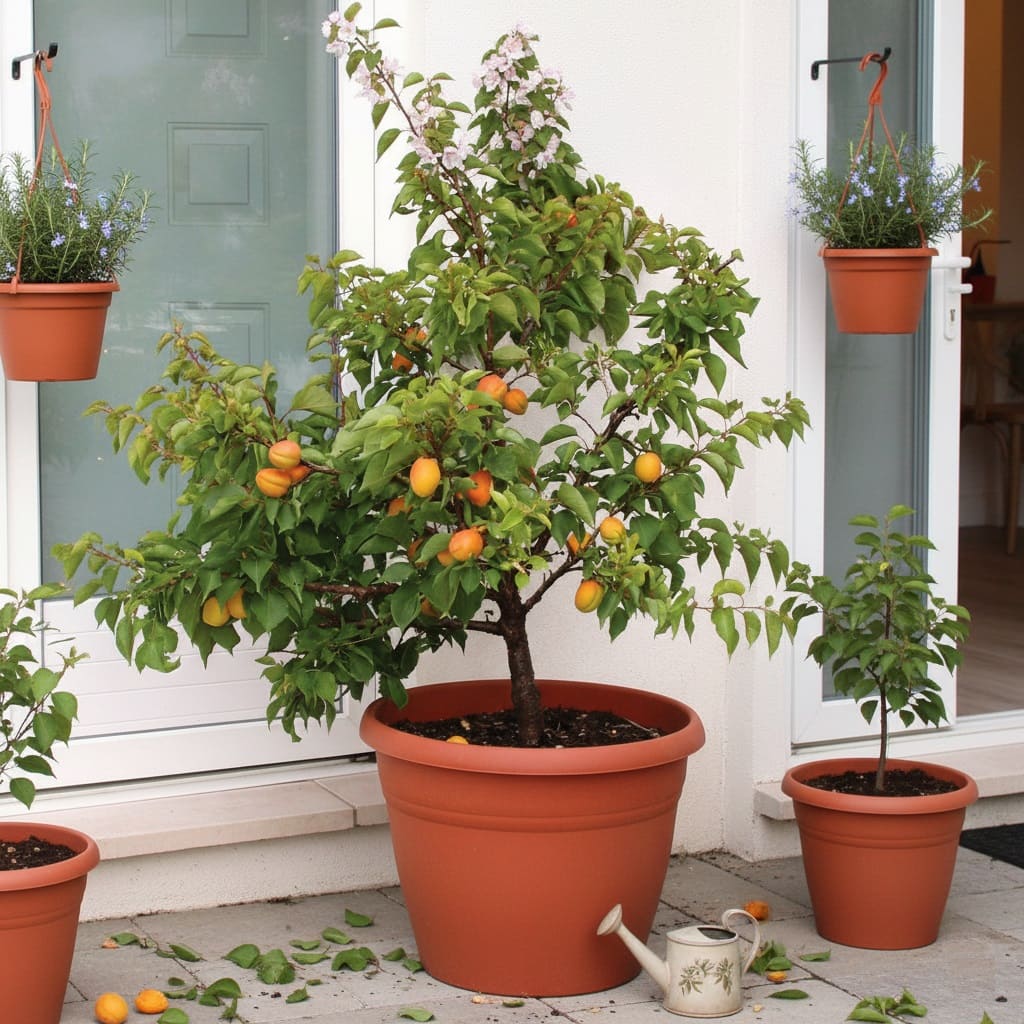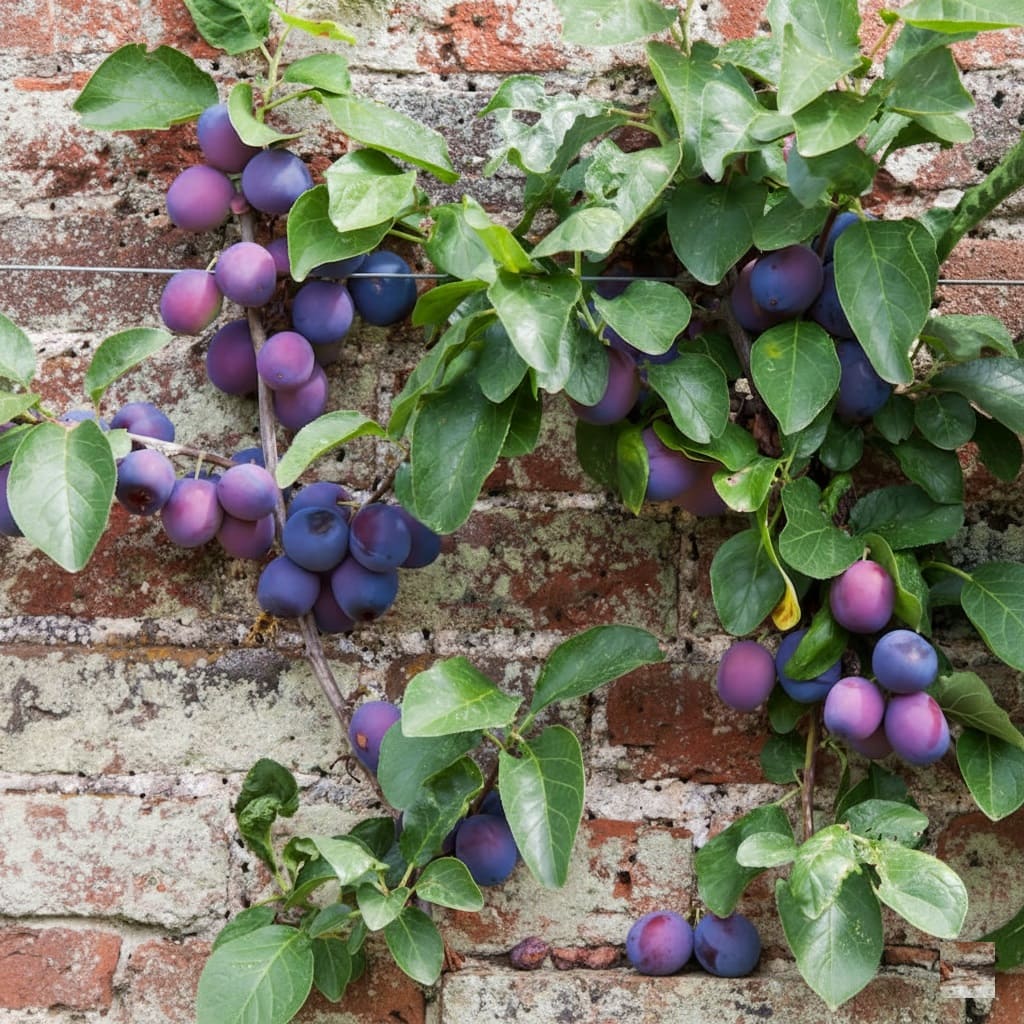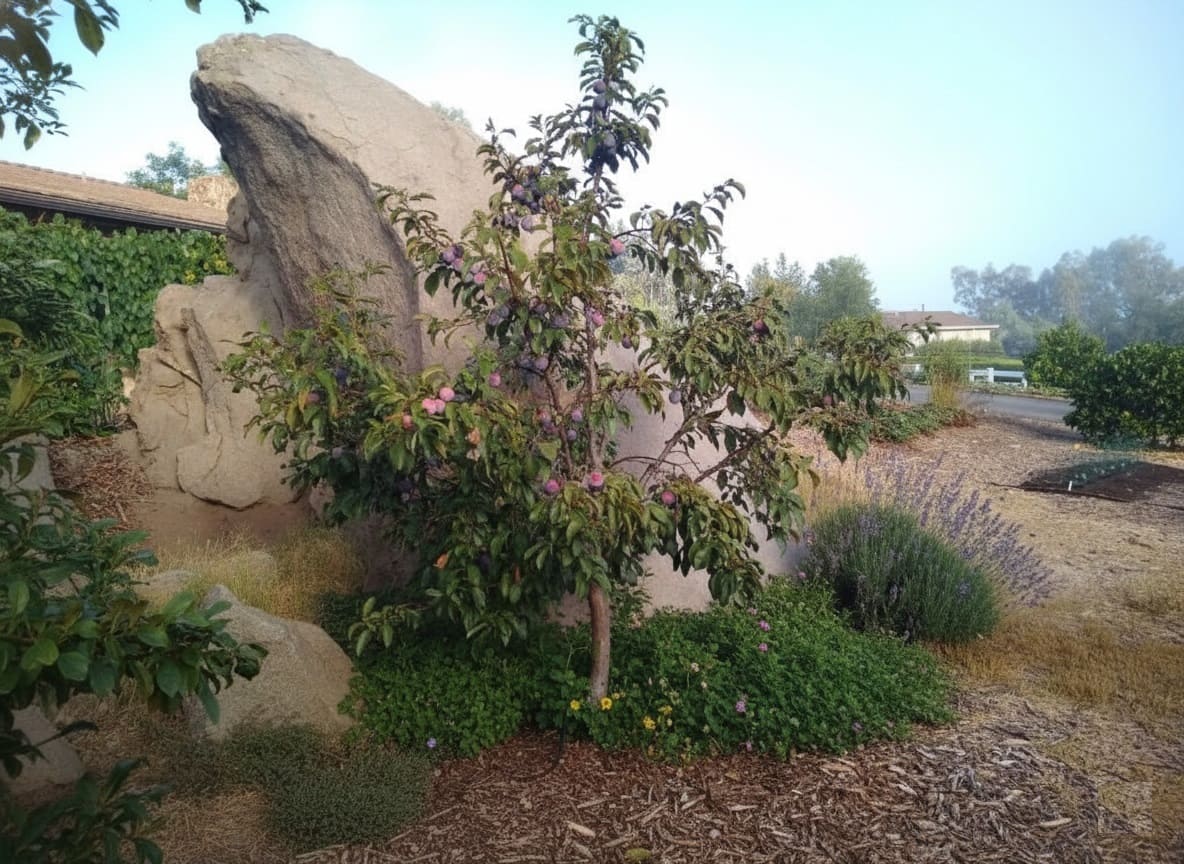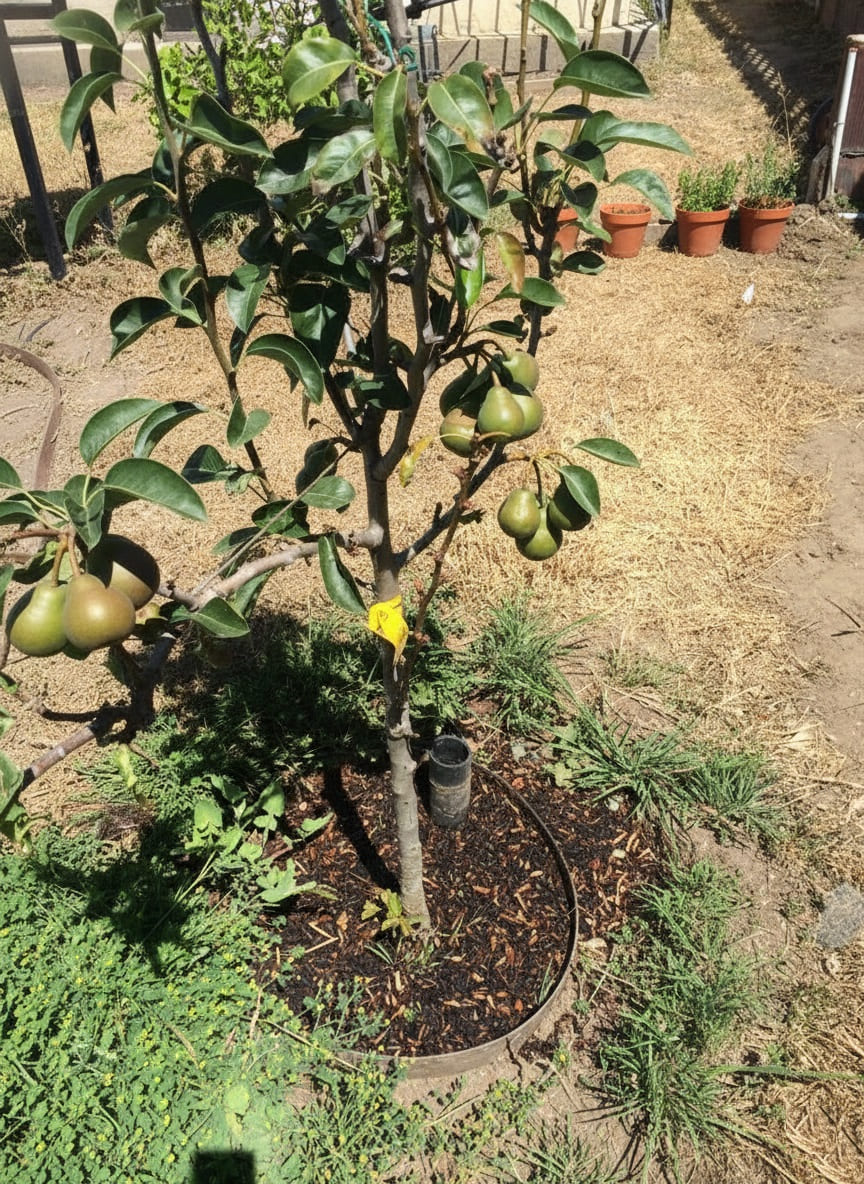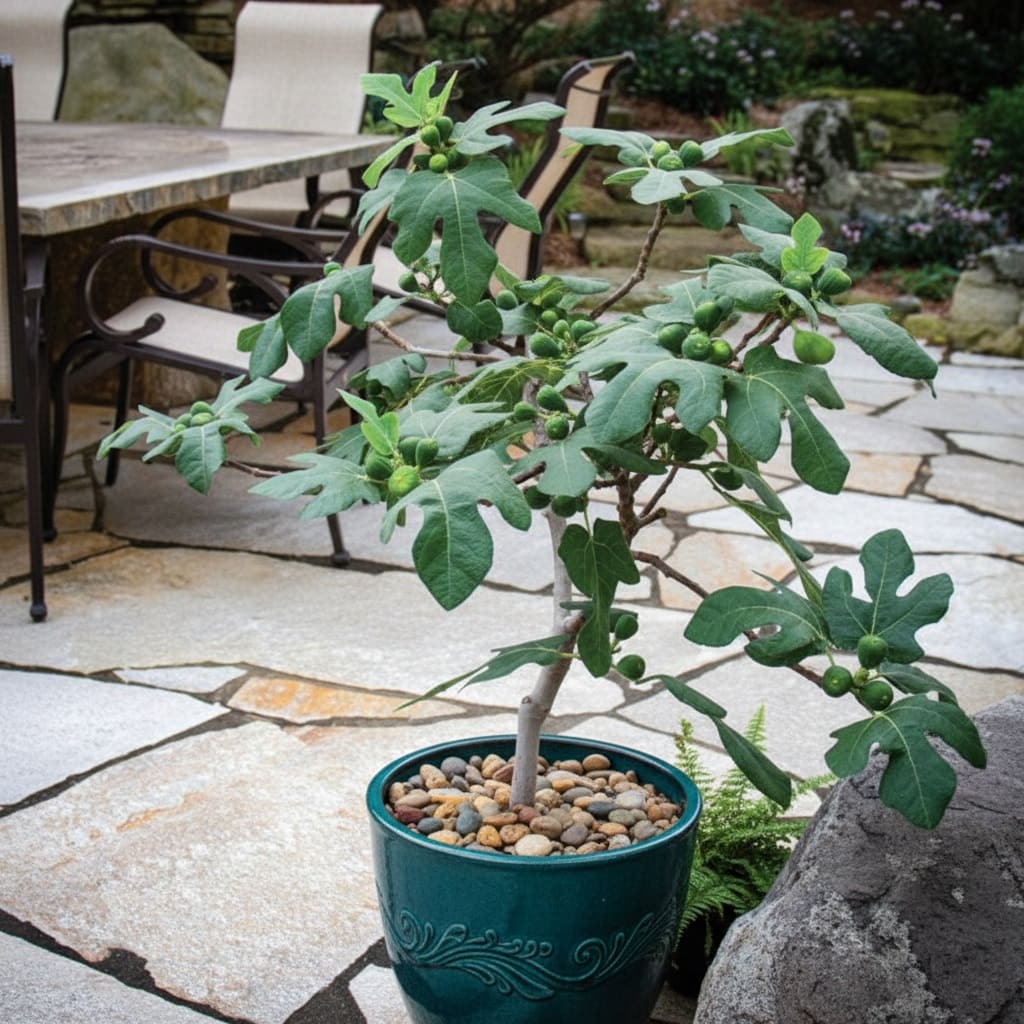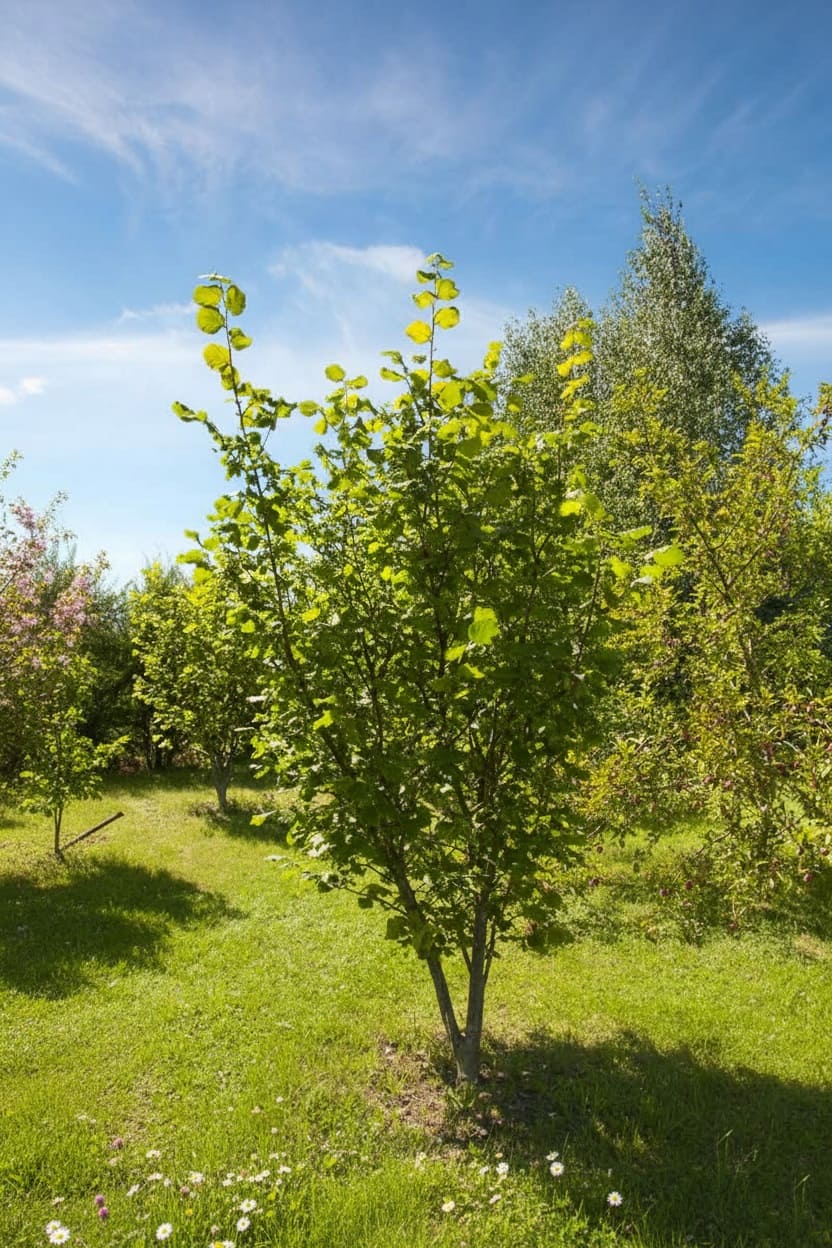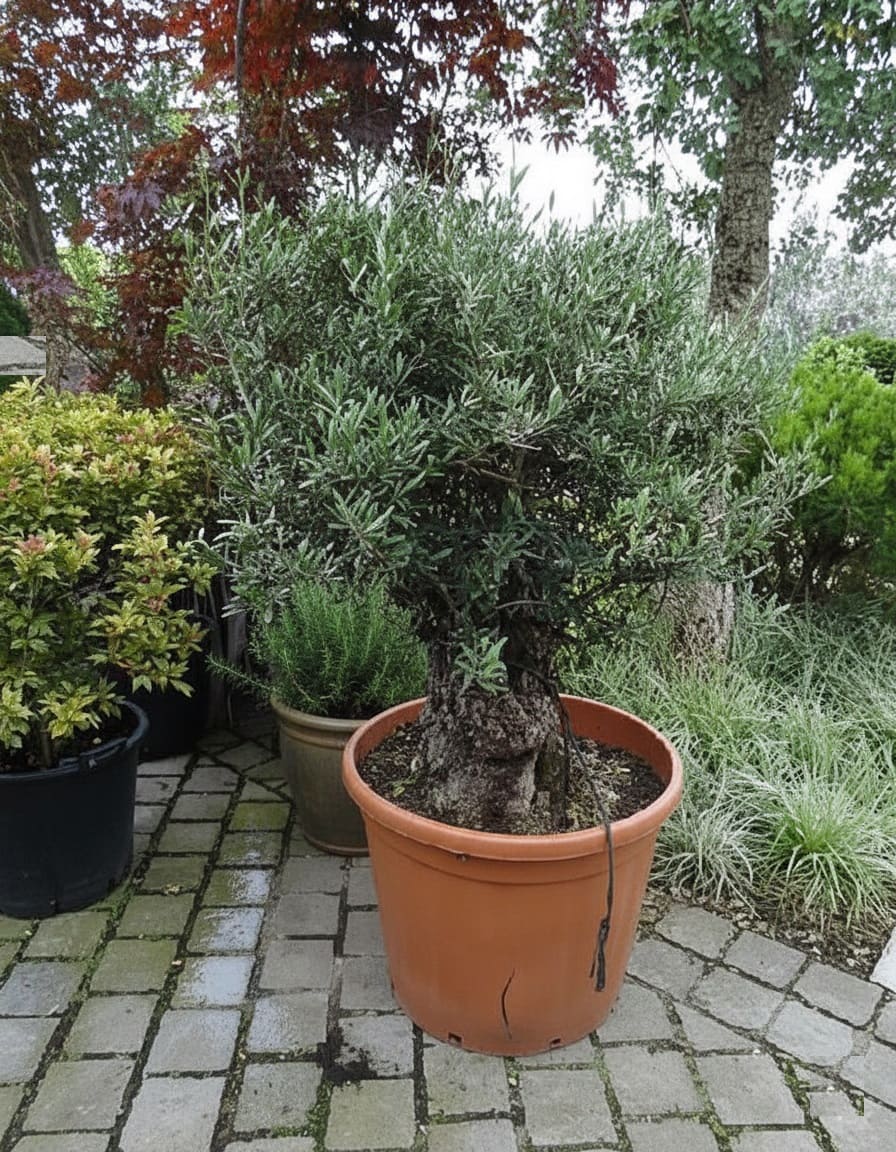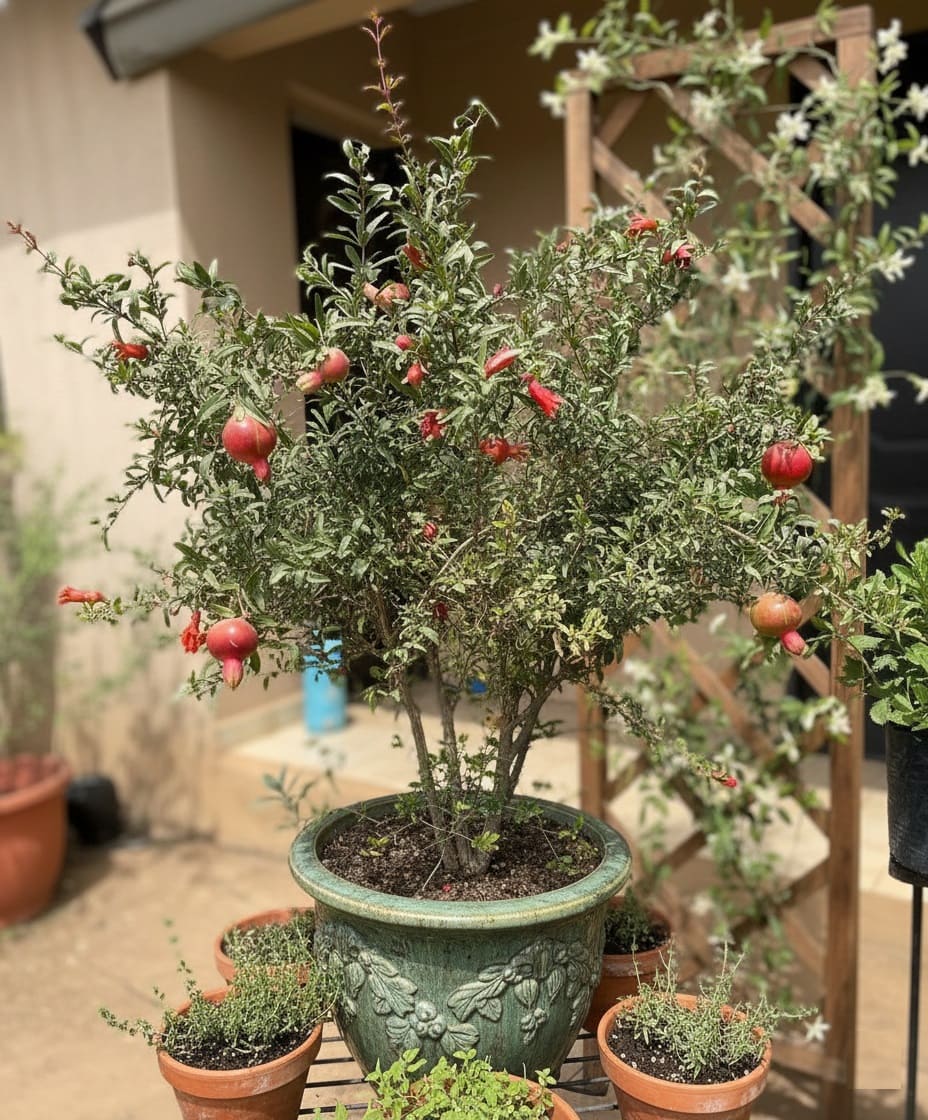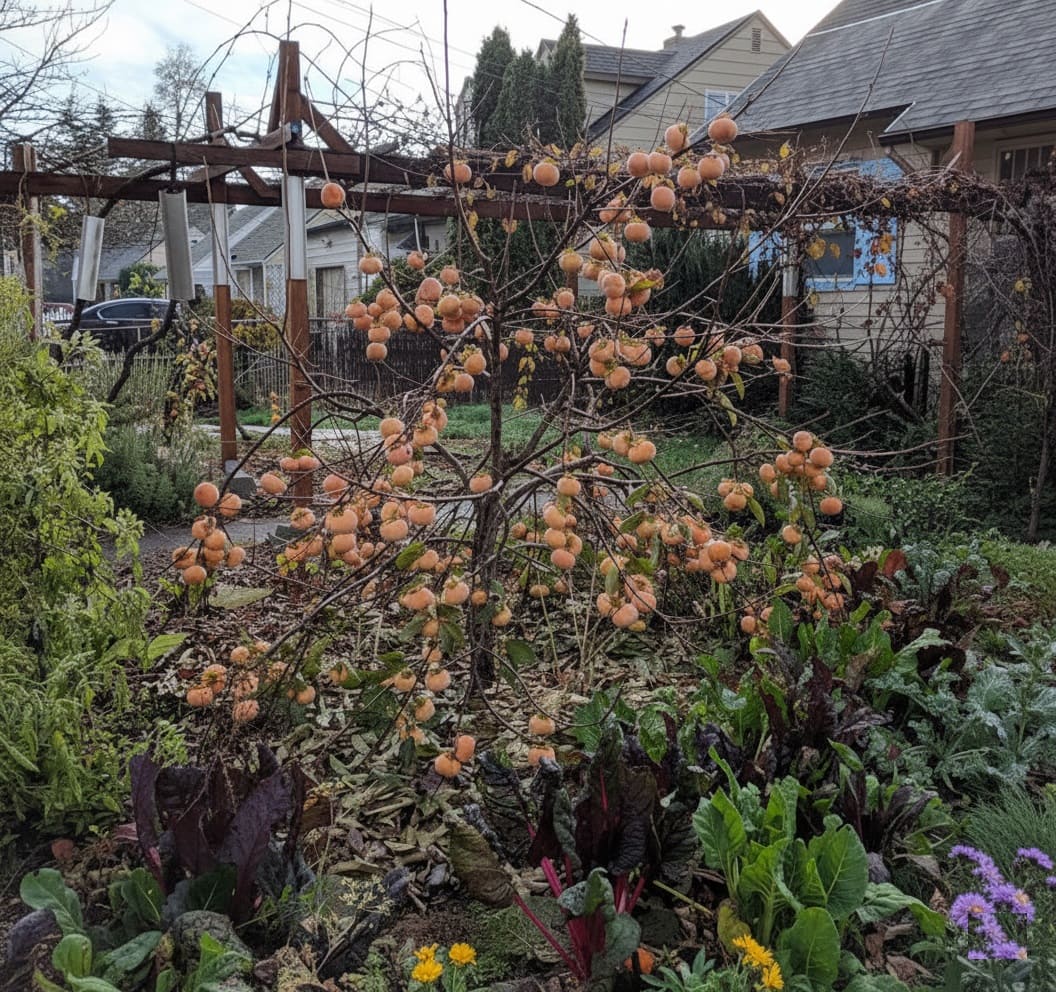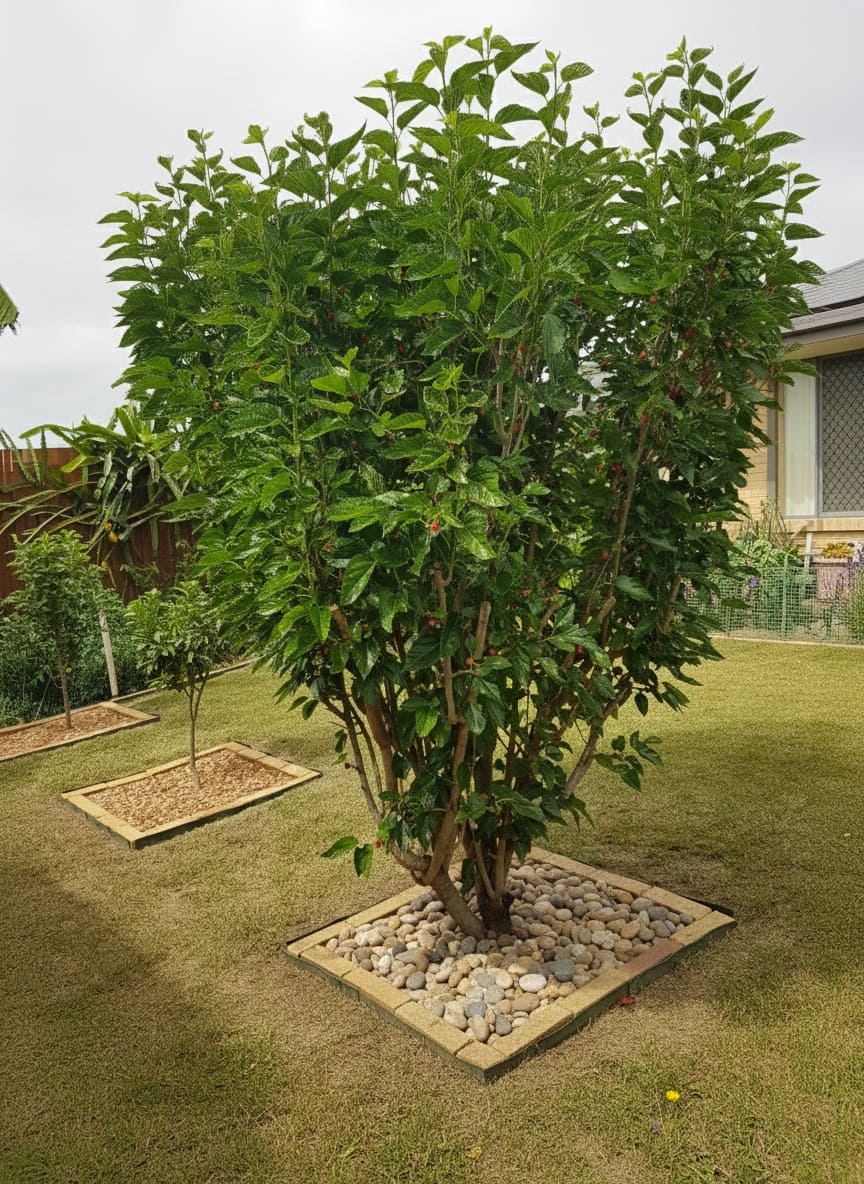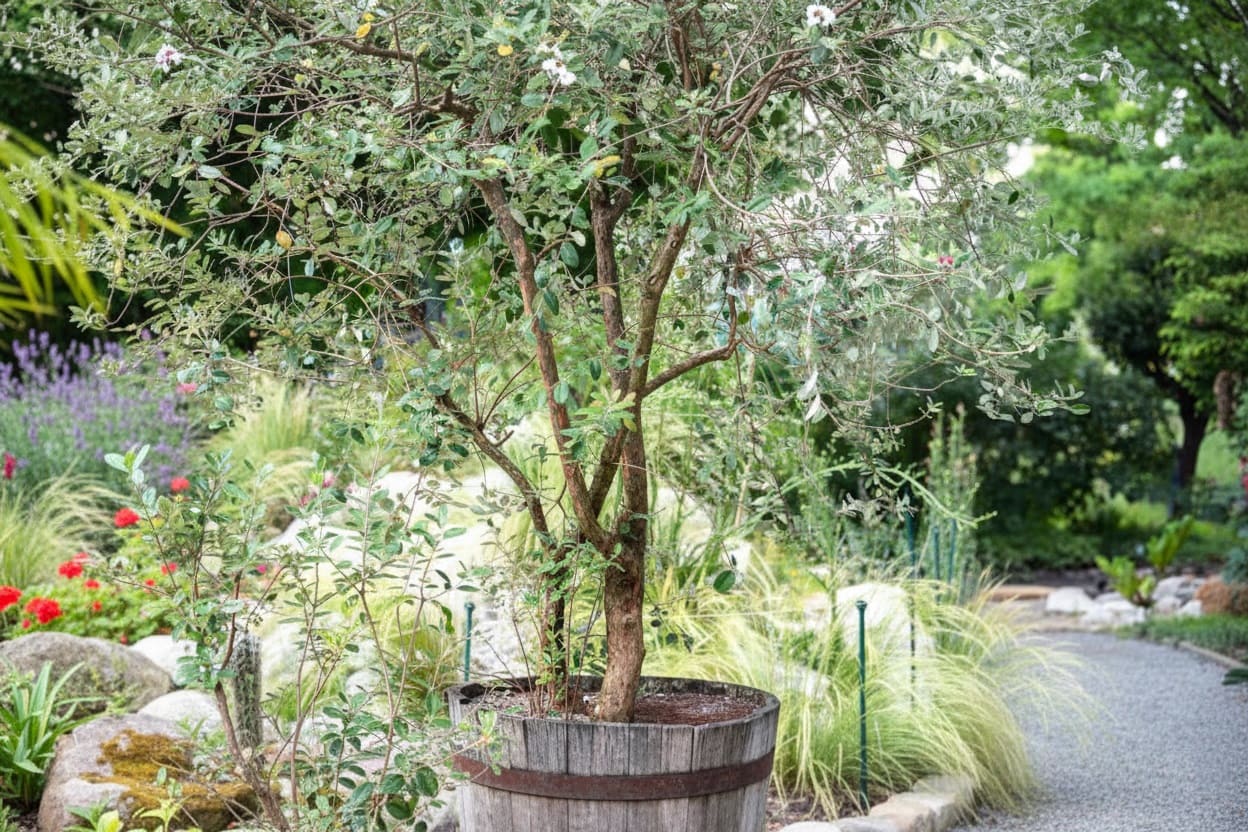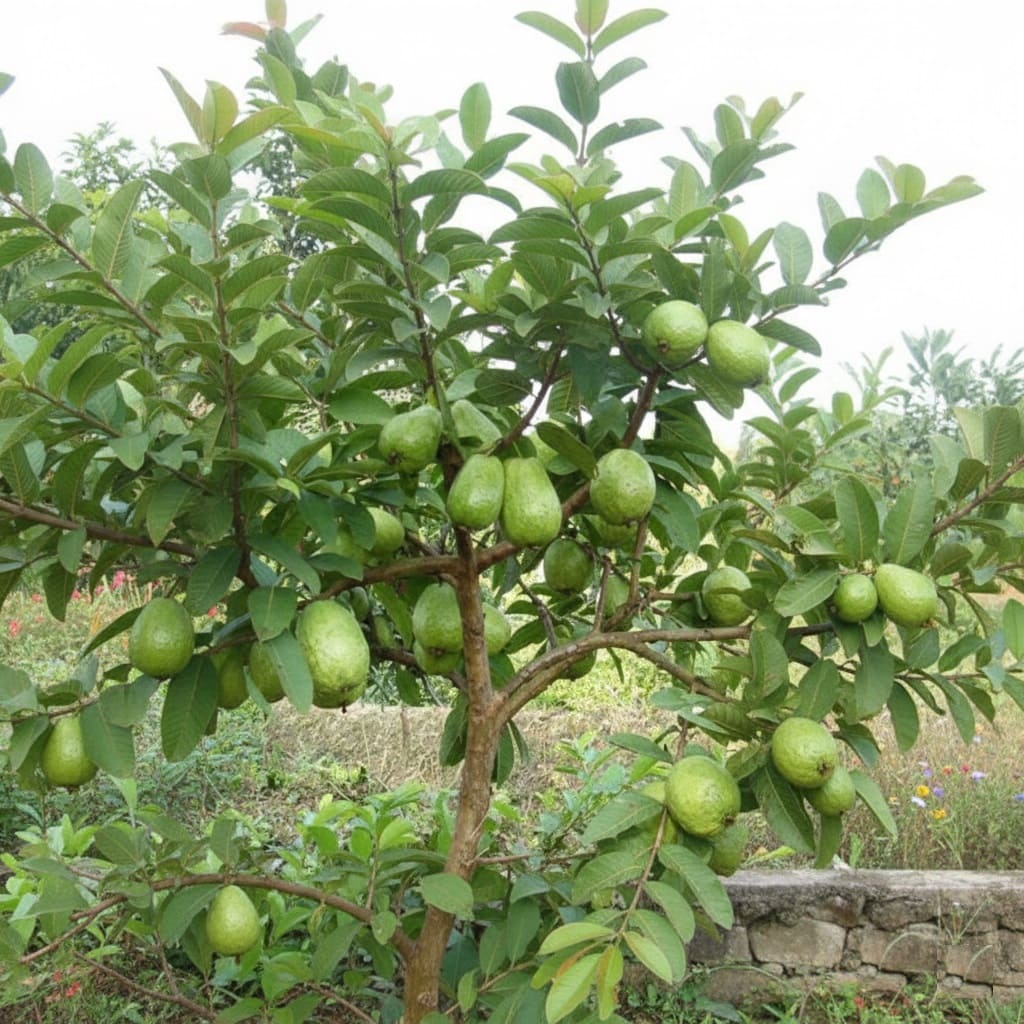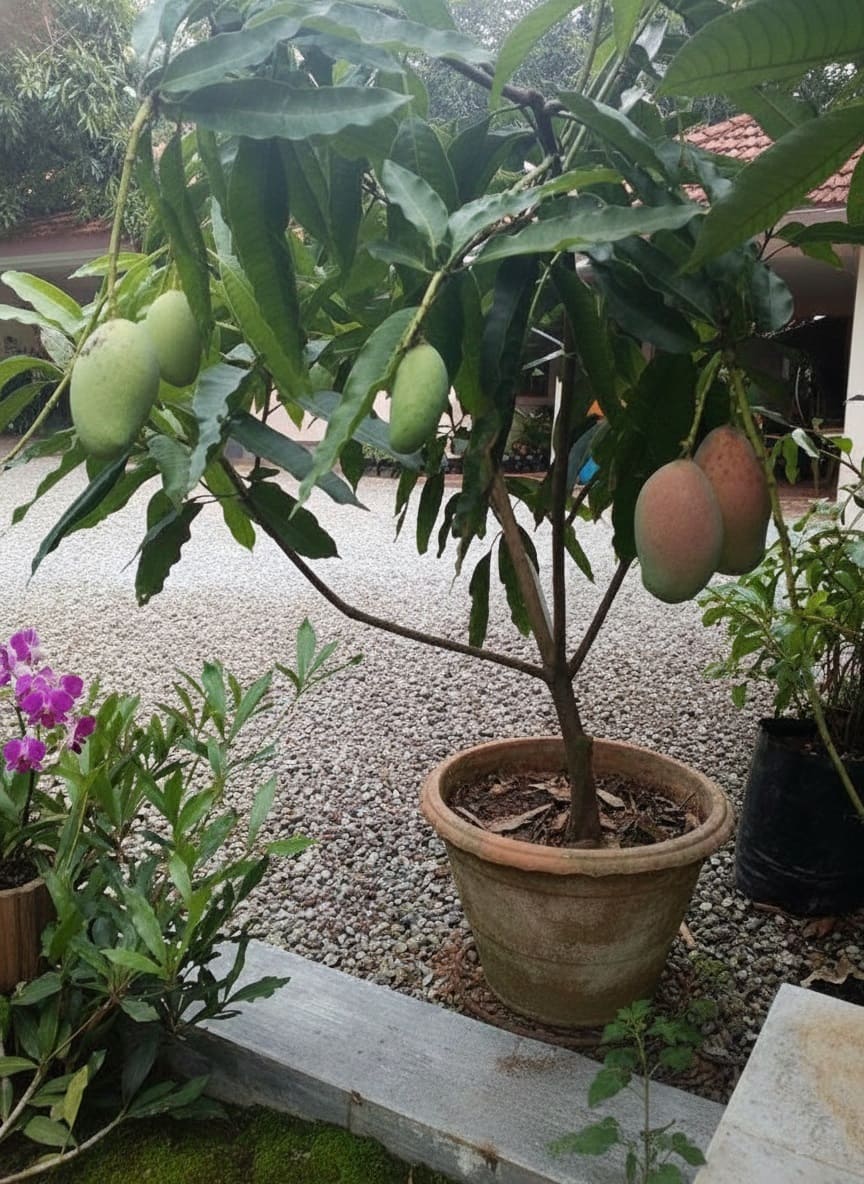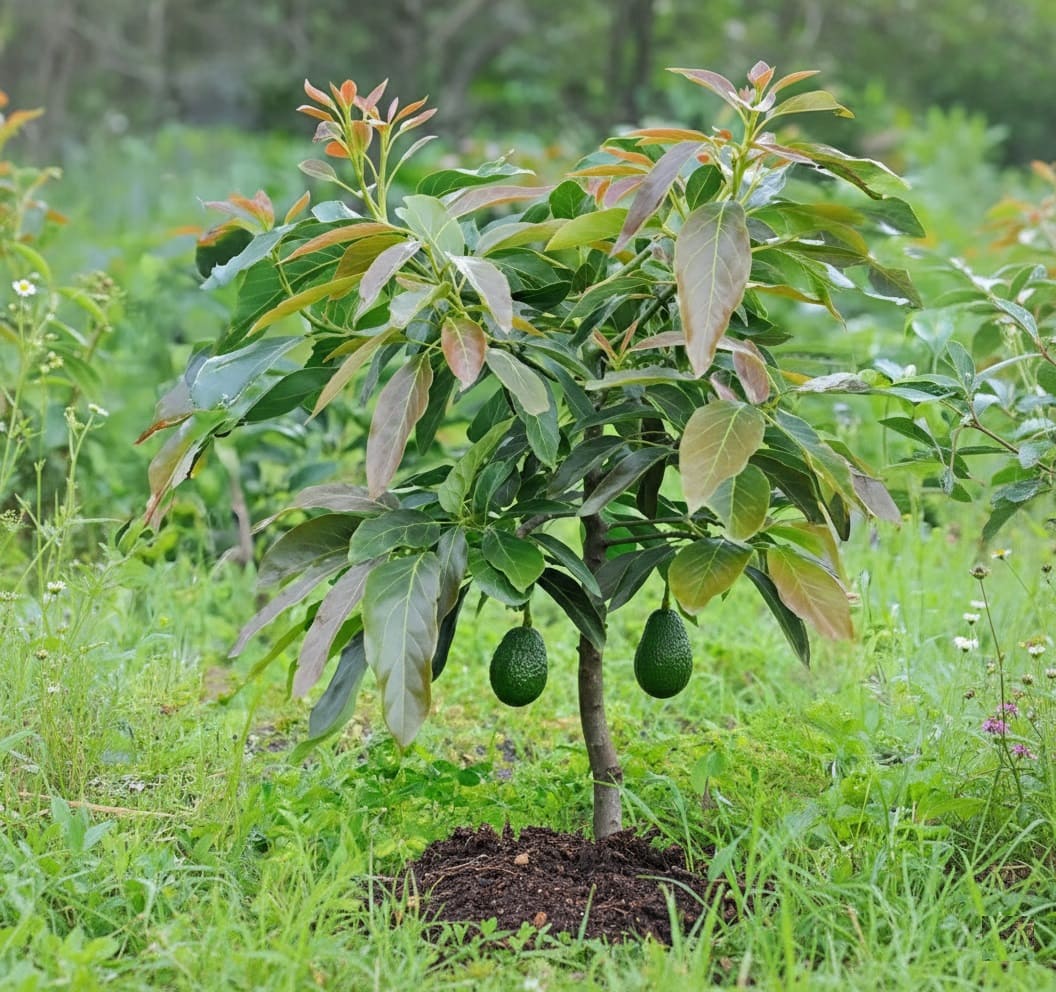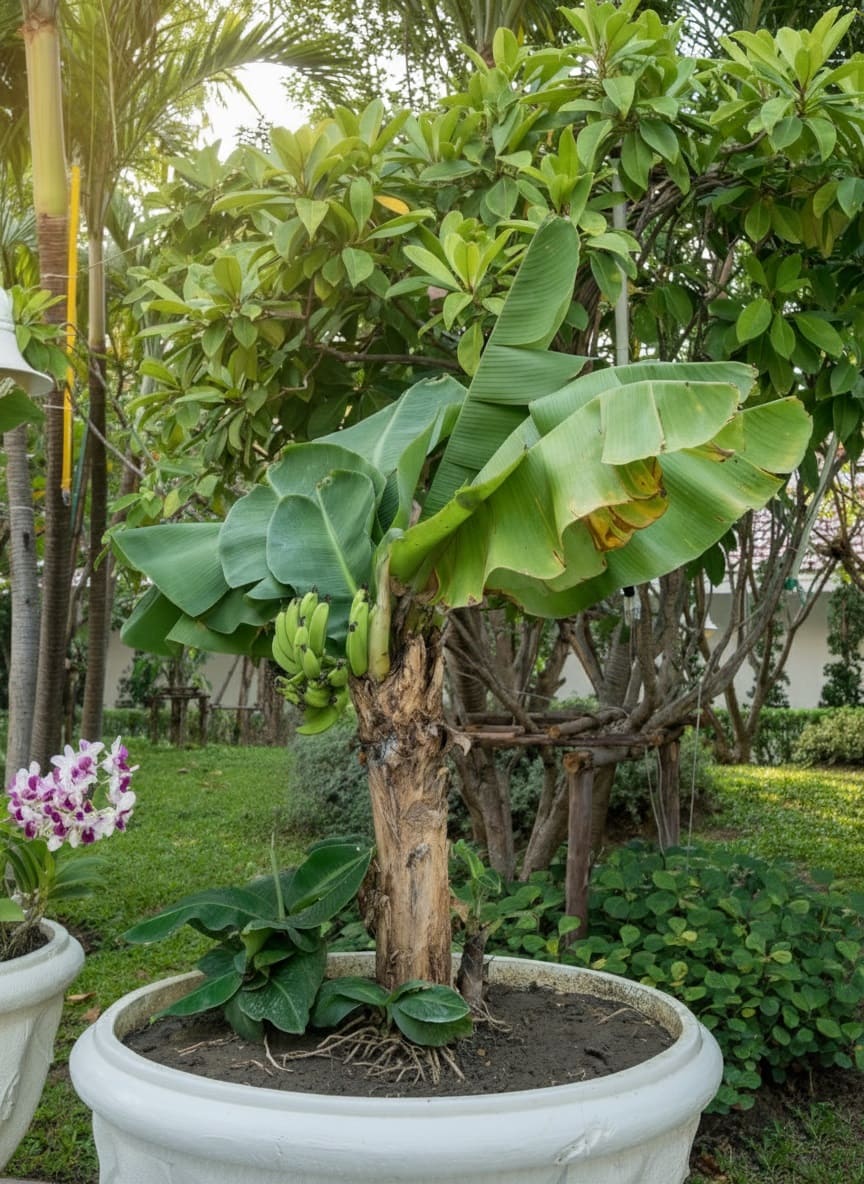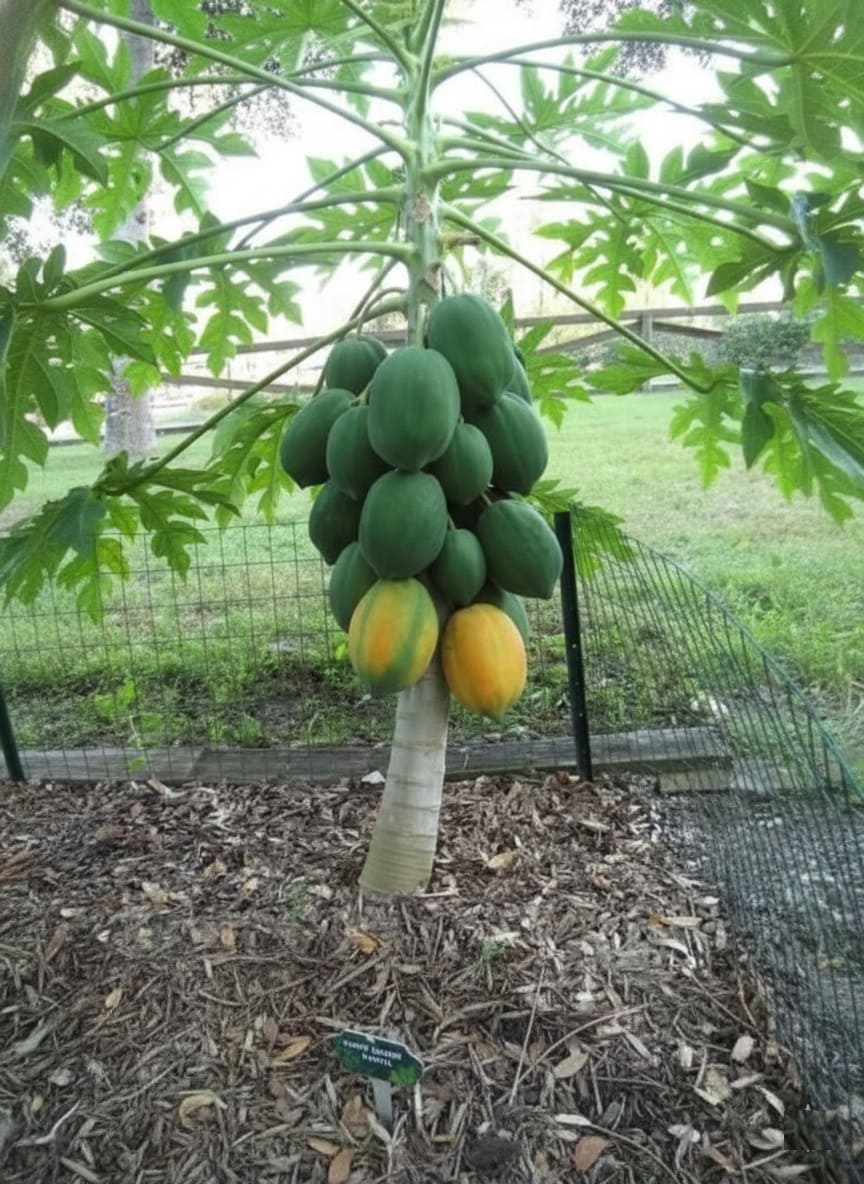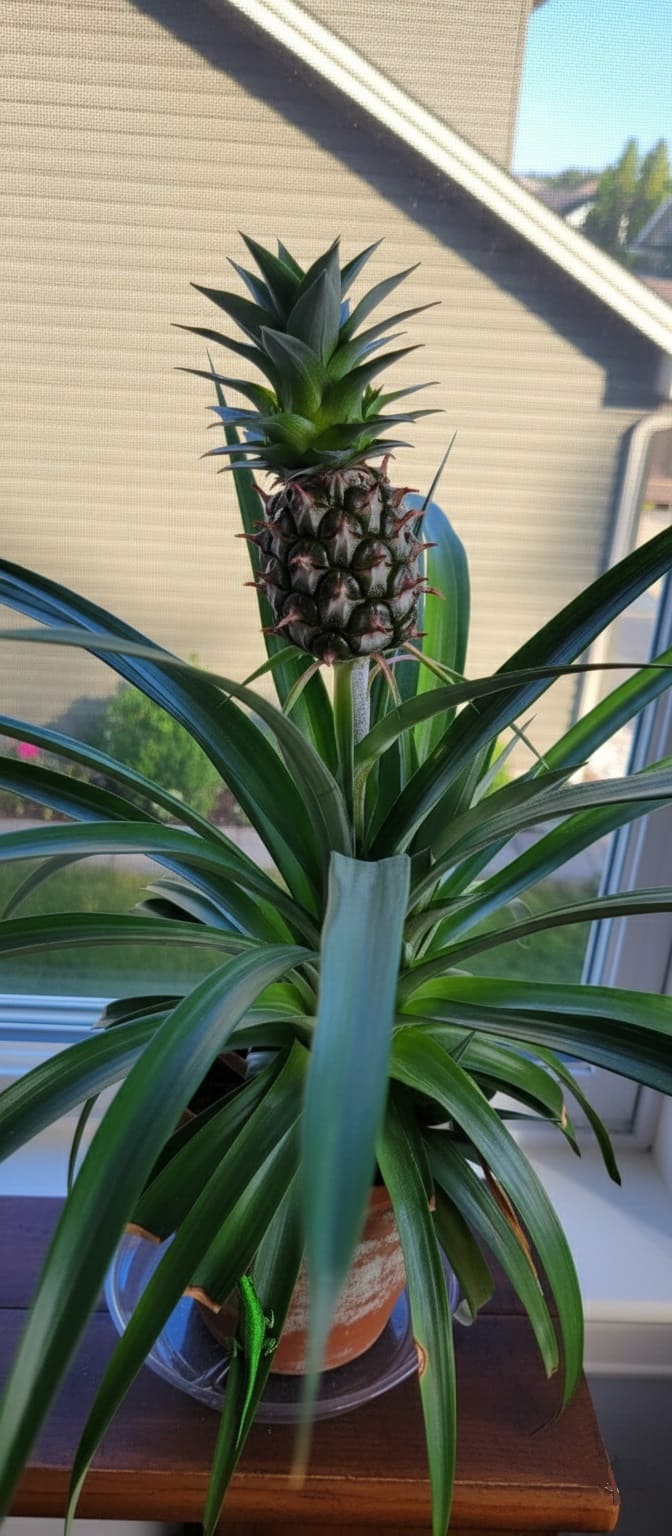Picture this: You step into your compact backyard and pluck a sun-warmed peach from your own tree—no ladder required. This isn’t a fantasy reserved for country estates.
Whether you’re working with a tiny urban yard, a sunny balcony, or a modest patio, you can absolutely grow your own fruit.
By the end of this guide, you’ll know exactly which dwarf trees will thrive in your space, how to care for them, and what realistic expectations to set for your mini orchard.
What Makes a Fruit Tree “Dwarf”?
Dwarf fruit trees aren’t genetically modified—they’re created through grafting, an ancient horticultural technique dating back thousands of years.
Here’s the process: A skilled grower takes a cutting from a fruit tree with exceptional fruit quality (say, Honeycrisp apples) and joins it to the roots of a different tree selected for specific characteristics.
This rootstock determines the tree’s ultimate size, disease resistance, cold hardiness, and even how quickly it bears fruit.
Understanding Rootstock Labels
When shopping for dwarf trees, you’ll encounter rootstock codes. Here’s what they mean:
- For Apples: M27 produces the smallest trees (6-8 feet), M9 creates standard dwarf trees (8-10 feet), and M26 gives semi-dwarf size (12-15 feet).
- For Cherries: Gisela 5 keeps trees compact at 8-10 feet.
- For Pears: Quince C produces the smallest pears (8-10 feet).
- For Stone Fruits: Pixy (plums), St. Julien A (apricots), and various peach seedling rootstocks offer different size controls.
- For Citrus: Flying Dragon rootstock creates true dwarf citrus trees across all varieties.
The rootstock package includes more than size control—it delivers pest resistance, soil adaptability, and drought tolerance. This explains why the same apple variety can cost different amounts: you’re paying for the rootstock’s proven performance characteristics.
Why Dwarf Trees Transform Small-Space Gardening
Faster Harvests
Standard fruit trees demand five to seven years before producing. Dwarf varieties typically bear fruit in two to three years, with some citrus and figs producing within twelve months.
That’s the difference between waiting for kindergarten versus getting fruit from a toddler-age tree.
Safety and Accessibility
Everything stays within arm’s reach. You’ll prune, spray, thin fruit, and harvest from the ground—no ladders, no risk, no excuse not to maintain the tree properly. This matters especially for older gardeners or families with children eager to help.
Genuine Space Efficiency
Instead of one twenty-foot apple tree dominating your yard, you could plant four different dwarf varieties in the same footprint.
This means extending your harvest season from a single August week to June through October by selecting early, mid, and late-season varieties.
Container Versatility
Renters can take their trees when moving. Cold-climate gardeners can grow lemons by wheeling them indoors for winter. Balcony dwellers can harvest fresh limes. The flexibility genuinely revolutionizes who can grow fruit.
👉 Read the Delayed Planting Guide: Tips for Successful Container Tree Care
Setting Realistic Expectations
Here’s the unvarnished truth about dwarf trees: they require less maintenance than standard trees, not zero maintenance.
Size Reality by Climate
In temperate zones (roughly zones 4-8), dwarf apples, pears, and stone fruits reliably stay compact at 8-10 feet with basic annual pruning. These rootstocks have been refined over decades.
In subtropical and tropical zones (9-11), “dwarf” mango or avocado means slower, bushier growth—but these trees can still eventually reach 15-20 feet without pruning. They just take years longer than vigorous varieties.
The Pruning Truth
All fruit trees benefit from annual pruning for productivity, health, and size management. Dwarf trees simply need less dramatic pruning—think light shaping rather than major surgery.
Skip pruning entirely and even dwarf trees will outgrow their intended size within a few years.
👉 Here’s How to Prune Roses: A Simple Guide for Stunning Results
Planning Your Space: Spacing and Layout
Minimum Spacing Guidelines
- Full dwarf trees: 8-10 feet apart
- Semi-dwarf trees: 12-15 feet apart
- Columnar varieties: 2-3 feet apart (perfect for edible hedges)
- Container trees: Can be placed closer (5-6 feet) since you control their size
These spacings assume you’ll prune annually. Plant closer and trees will compete for light and nutrients.
Vertical Space Solutions
If horizontal space is extremely limited, train trees as espaliers—flattened against walls, fences, or trellises. Apples, pears, and stone fruits adapt beautifully to this technique.
An espaliered tree might occupy just 18 inches of depth while spreading 8-10 feet horizontally along a sunny fence. You can fit an orchard along a property line that would otherwise grow nothing but grass.
Your Dwarf Fruit Tree Shopping List
Apples: The Reliable Backbone
Dwarf apples deliver consistent results across zones 3-8. Top varieties include Honeycrisp (crisp, sweet), Fuji (stores well), and Gala (early harvest).
For disease resistance, seek out Liberty, Enterprise, or Freedom—these naturally resist apple scab and other common problems.
- Space-saving stars: Columnar apples like Scarlet Sentinel, Northpole, or Golden Sentinel grow just 2 feet wide and 8-10 feet tall. Plant three different varieties in the space one regular tree would occupy.
- Pollination requirement: Most apples need a partner. Plant two different varieties that bloom simultaneously, or choose self-fertile varieties like Granny Smith or Golden Delicious.
👉 Discover 35+ Apple Varieties With Selection Tips & Their Perfect Uses
Crabapples: Ornamental Meets Edible
Often overlooked, dwarf crabapples pack remarkable value into compact packages. These hardy trees (zones 3-9) reach just 6-10 feet tall and produce abundant crops of small, tart fruits perfect for jellies, preserves, and cider.
Whitney and Dolgo varieties offer larger fruits (up to 2 inches) with better eating quality when fully ripe. Lollipop crabapple stays especially compact at 8 feet with a rounded shape.
Most crabapples are self-fertile and bloom with spectacular pink or white flowers in spring, making them dual-purpose trees for small spaces.
The fruits store well, and their high pectin content makes them invaluable for helping other fruits gel when making preserves.
Plus, crabapples are among the hardiest fruit trees you can grow, tolerating harsh winters and variable conditions that would stress more temperamental fruits.
Citrus: The Container Champions
Meyer lemons lead in popularity for excellent reason—sweeter than standard lemons with mandarin undertones, thriving in containers, and producing year-round in warm climates.
1. Lemons and Limes:
Beyond Meyer, consider Bearss Persian lime (productive and tangy), Key lime (intensely flavored, 6-12 feet), and Variegated Pink Eureka lemon (striped foliage with pink-fleshed fruit).
2. Oranges:
Calamondin oranges make outstanding ornamental trees at 6-10 feet with tart fruit for marmalade. Lane Late and Cara Cara navels both adapt well to containers at 8-15 feet. For something unique, try the Blood Orange for its dramatic ruby-red flesh.
3. Mandarins and Tangerines:
Satsumas are the cold-hardiest citrus (surviving to 20°F), making them perfect for zone 8. Dancy tangerine reaches 10-15 feet with classic tangerine flavor. Golden Nugget mandarin stays compact at 8-12 feet with sweet, seedless fruit.
4. Grapefruit:
Melogold and Cocktail grapefruit varieties grow as semi-dwarfs (10-15 feet), producing sweeter, less bitter fruits than standard grapefruit. They need consistent warmth (zones 9-11) but reward you with massive fruits.
5. Kumquats:
These unique citrus are eaten whole—peel and all. Nagami (tart) and Meiwa Sweet (milder) both stay under 8 feet and tolerate cold down to 20°F, making them more cold-hardy than most citrus.
The limequat (kumquat-lime hybrid) reaches just 6-7 feet with tangy fruit perfect for drinks.
- Zone flexibility:
Citrus grows outdoors year-round in zones 9-11, but nearly any variety succeeds in containers moved indoors for winter in colder zones. Provide a south-facing window or grow lights.
- Pollination:
Self-fertile—one tree produces fruit.
Stone Fruits: Summer’s Sweet Reward
1. Peaches:
Bonanza, Elberta, and Garden Lady grow with adorable mop-top shapes on 6-8 foot trees. All self-pollinate. For something unusual, try Donut peach (flat, sweet, 8-10 feet) or Red Baron (burgundy leaves, double-duty ornamental).
2. Nectarines:
Garden Delight and Nectar Babe stay compact at 4-6 feet. Fantasia offers larger fruit on a slightly bigger tree (8-10 feet). All are fuzzless versions of peaches with similar care requirements.
3. Cherries:
Stella sweet cherry stays compact (8-10 feet) and self-pollinates. For pie cherries, Montmorency produces abundantly in zones 4-7.
Compact Stella and North Star tart cherry are especially productive for their size. Romeo, Juliet, and Crimson Passion are Canadian-bred dwarf varieties bred for extreme cold (zone 3-4).
4. Apricots:
Best in zones 4-7 with cold winters. Sugar Pearls and Aprigold offer reliable production on compact frames (8-10 feet). Garden Aprigold is naturally more compact at 6-8 feet.
5. Plums:
Stanley (blue-purple, great for canning) and Damson (tart, self-fertile) both work well as dwarf trees. For something different, try the Weeping Santa Rosa—a dramatic ornamental with cascading branches that reaches 10 feet and produces excellent fruit.
6. Hybrid Fruits:
Pluots (plum-apricot, 75% plum) like Dapple Dandy grow 10-12 feet with incredibly sweet fruit. Plumcots (50-50 hybrid) and Nectacots (nectarine-apricot) like Honey Pearls add diversity to small orchards with unique flavors.
Pears: The Patient Producer
Pears take longer to establish than apples (4-6 years to full production) but they’re incredibly long-lived and disease-resistant. Conference, Bartlett, and D’Anjou all perform well on dwarf rootstock at 8-10 feet.
Asian Pears:
These apple-pear hybrids offer crisp texture with pear flavor. Shinseiki (zones 5-9), 20th Century, and Chojuro all thrive as dwarf trees. They’re exceptionally productive and store well.
- Note: Most pears require cross-pollination with a different variety. Asian pears can pollinate European pears if bloom times overlap.
Figs: The Cold-Hardy Surprise
Dwarf figs punch above their weight class. Little Miss Figgy (zones 7-10, reaches 5-7 feet) and Fignomenal (just 2-3 feet!) produce abundantly.
Chicago Hardy survives zone 5 with protection and grows to 8-10 feet. Brown Turkey is reliable and widely adapted (zones 6-10, 7-10 feet).
Figs are naturally compact, self-fertile, and handle container life beautifully. They fruit twice annually in warm climates—once on old wood in early summer, again on new growth in fall.
👉 Learn about Harnessing Fig Sap For Natural Remedies, Vegan Cheese, and More
Nuts in Small Packages
1. Almonds:
Dwarf almonds reach 8-10 feet and produce both beautiful spring blooms and nutritious nuts. Self-pollinating varieties eliminate the need for multiple trees.
They need zones 5-9 with dry summers and 250-400 chill hours. The nuts ripen in late summer when hulls split.
2. Hazelnuts:
While not typically grafted as dwarfs, some naturally compact hazelnut varieties stay under 12 feet. They’re more shrub than tree, making them perfect for hedgerows or mixed plantings in zones 4-8.
👉 Discover more Profitable Nut Trees to Grow: Which Varieties Are Worth Investing In
Mediterranean Beauties
1. Olives:
Arbequina olive trees adapt wonderfully to containers, reaching 8-10 feet with silvery-green foliage. They’re self-pollinating (though yields improve with a partner) and cold-hardy to zone 7.
The small olives are perfect for curing or pressing for oil. Dwarf varieties need well-drained, sandy soil and tolerate drought once established.
2. Pomegranates:
These ornamental edibles combine gorgeous orange blooms with jewel-toned fruit. Wonderful, Sirenevyi, and Dwarf Red varieties reach 8-12 feet. They’re heat-loving (zones 7-11), drought-tolerant, and self-fertile.
Pomegranates grow as wide as they are tall, so plan accordingly. The dwarf Nana pomegranate stays exceptionally compact at just 3 feet—perfect for containers.
Unique Fruits for Adventurous Growers
1. Persimmons:
Dwarf Asian persimmons like Ichi-Ki-Kei-Jiro grow 8-10 feet tall in zones 6-9. These low-maintenance trees are self-fertile and produce sweet, honey-flavored fruit that ripens in fall. American persimmons are hardier (zone 4-9) but need a pollinator.
👉 Here’s How to Eat Persimmons the Right Way: Fuyu vs. Hachiya Explained
2. Mulberries:
Dwarf Everbearing mulberry stays under 10-15 feet and produces continuously from June through September. The berries taste like a cross between blackberries and raspberries.
Illinois Everbearing and World’s Best are other compact varieties. They’re self-fertile, extremely productive, and adapt to zones 5-10. Fair warning: the dark berries stain, so plant away from patios and driveways.
👉 Here’s How to Grow Mulberry Trees: Best Varieties, Care, and Harvest Tips
3. Jujube:
Also called Chinese dates, these drought-tolerant trees reach 15-20 feet but can be pruned shorter. Honey Jar, Sugar Cane, and Lang varieties produce crispy, sweet fruits with apple-like texture.
They’re incredibly tough (zones 5-10), handle poor soil, and resist pests naturally. Self-fertile varieties exist, though cross-pollination increases yields.
4. Loquats:
These evergreen trees (zones 8-11) produce tangy-sweet apricot-like fruits in spring. Coppertone loquat stays compact at 8 feet, making it container-friendly.
The fruit ripens weeks before most other fruits, filling the early-season gap. Plus, those large tropical leaves create wonderful visual interest.
5. Pineapple Guava (Feijoa):
This evergreen beauty thrives in zones 8-10, reaching 10-15 feet. The gray-green foliage, showy edible flowers, and sweet-tart fruits (tasting like pineapple-strawberry-mint) make it a multi-season stunner.
Most varieties need cross-pollination, so plant two different cultivars.
6. Pawpaw:
America’s largest native fruit tastes like banana-mango custard. NC-1, Prolific, and SAA Overleese varieties work well as semi-dwarfs (12-15 feet) in zones 4-8.
They tolerate shade better than most fruit trees and need minimal care once established. Plant two different varieties for pollination.
7. Guava:
Tropical guava (zones 9-11) produces aromatic fruits with pink flesh. Ruby Supreme stays under 10 feet. They need warmth, humidity, and protection from frost but reward you with multiple harvests per year in ideal conditions.
Tropical Options for Warm Climates
Zones 9-11 unlock more possibilities:
1. Mangos:
Dwarf varieties like Cogshall, Pickering, Ice Cream, and Carrie reach 10-15 feet (even as “dwarfs”). They’re slow growers that can be maintained smaller with pruning. Expect sweet, fiber-free fruits once trees mature (3-5 years).
👉 Here’s How to Grow a Mango Tree from Seed: A Simple Guide for Beginners
2. Avocados:
Compact varieties include Wurtz (also called “Little Cado,” 8-12 feet), Day, and Mexicola. These produce creamy fruits while staying manageable. Holiday avocado is self-pollinating—rare for avocados.
3. Bananas:
Dwarf Cavendish reaches 8-10 feet and produces full-sized bananas. Dwarf Orinoco and Dwarf Namwa are other productive varieties perfect for tropical and subtropical gardens.
👉 Related post: Are Bananas an Herb? The Surprising Truth About This Everyday Fruit
4. Papayas:
Naturally compact at 6-10 feet, papayas fruit within a year of planting in zones 10-11.
They’re technically large herbaceous plants rather than trees, with a short productive life (3-5 years), but the prolific fruiting and tropical flavor make them worthwhile.
5. Dragonfruit:
This cactus grows 5-10 feet as a climbing plant that can be trained on a trellis or stake. Many varieties fruit in their first year with night-blooming flowers that are spectacularly beautiful. Zones 9-11, but widely grown in containers elsewhere.
6. Pineapple:
Standard pineapples grow just 3-6 feet tall—naturally dwarf! Florida Special is the most common variety. One plant produces one pineapple, then sends out side shoots (pups) that become new plants. Grow in zones 10-11 or containers in bright indoor light.
👉 Find out What Are Pink Pineapples? Everything You Need to Know About This Viral Fruit
- Colder zone strategy: Grow tropical varieties in containers and bring indoors for winter, though fruiting will be minimal without proper light and warmth.
The Three Critical Factors for Success
Sunlight: Non-Negotiable
Fruit trees need 6-8 hours of direct, unfiltered sunlight daily. Less sun means dramatically reduced fruit production or none at all.
- Partial shade options: If you only have 4-6 hours of sun, your choices narrow to Morello cherries, certain apple varieties bred for shade tolerance, figs, and mulberries—but expect smaller yields.
Soil: pH and Drainage Matter
Most fruit trees prefer slightly acidic to neutral soil (pH 6.0-7.0). Blueberries are the exception, demanding acidic soil (pH 4.5-5.5).
- Test before planting. Inexpensive soil test kits from garden centers reveal your pH. Most fruit trees tolerate a range but won’t thrive in extremely alkaline or acidic conditions.
- Drainage is critical. If water puddles for hours after rain, either build raised beds, create mounded planting areas, or choose containers. Waterlogged roots kill more fruit trees than any pest.
Climate Matching: Beyond Hardiness Zones
Your USDA zone tells only part of the story. Also consider:
- Chill hours: Apples, pears, cherries, and stone fruits need a certain number of hours below 45°F each winter to break dormancy and set fruit. Check both your zone (winter cold tolerance) and your area’s chill hours (usually 200-1000+ hours depending on variety).
- Summer heat: Peaches and nectarines love long, hot summers. Apples prefer warm days and cool nights. Citrus needs consistent warmth. Pomegranates and figs thrive in hot, dry climates.
- Microclimates: A south-facing wall radiates heat, effectively moving you half a zone warmer. Low-lying areas collect cold air (frost pockets). Observe your property’s unique conditions.
Container Growing Essentials
Container Selection
Start with 18-24 inch diameter pots (roughly 15-20 gallons). Plan to upsize every 18-24 months as trees grow. Maximum practical size is typically 24-30 inches (25-30 gallons) before pots become unmovable.
Choose containers with straight sides or that taper inward at the top—this lets you slide the rootball out when repotting. Fabric grow bags and Smart Pots solve this elegantly.
Soil Mix Formula
Skip regular potting soil—it compacts over time. Use a mix designed for trees: 40% quality potting mix, 30% compost, 30% perlite or coarse sand for drainage. For citrus, add extra perlite.
Watering Strategy
Container trees dry out significantly faster than in-ground trees. In summer, expect to water daily or every other day. The finger test never lies: stick your finger 2 inches deep. Dry? Water thoroughly until it drains from the bottom. Still moist? Wait.
Feeding Schedule
Container trees need regular feeding since nutrients wash through with watering.
Apply controlled-release fertilizer in early spring (use a fruit tree formula with lower nitrogen, higher phosphorus and potassium), then supplement with liquid fertilizer every 3-4 weeks during the growing season. Stop feeding in late summer.
Planting Your Tree Right
Timing
Spring planting gives trees maximum time to establish before winter stress. In mild climates (zones 8+), fall planting works well too—trees establish roots during cool weather without battling summer heat.
Container Planting Steps
- Place container on a rolling plant dolly before filling (thank yourself later)
- Add drainage material if desired (gravel, broken pottery)
- Fill partway with soil mix
- Position tree so the graft union sits 2-3 inches above the final soil line
- Backfill, firming gently to eliminate air pockets
- Water thoroughly
- Add 1-2 inches of mulch, keeping it away from the trunk
In-Ground Installation
- Dig a hole twice as wide but only as deep as the root ball
- Roughen the sides of the hole to help roots penetrate surrounding soil
- Mix compost with native soil (50/50 ratio)
- Create a small mound in the hole center
- Position tree with graft union 2-3 inches above ground level
- Backfill, tamping gently
- Create a watering basin around the tree’s drip line
- Water deeply
- Apply 3-4 inches of mulch in a donut shape (not touching trunk)
The Year-Round Care Calendar
Early Spring (Before Buds Break)
This is prime time for major pruning. Remove dead, diseased, or damaged wood. Cut away crossing branches. Take out any growth below the graft union (suckers). For established trees, thin branches to improve air circulation and light penetration.
Spring (Bud Break Through Bloom)
Watch for pests awakening with your trees. Monitor for aphids, spider mites, and scale. Spray dormant oil before buds swell if you had pest problems last year. Apply copper fungicide if fungal diseases appeared previously.
Late Spring/Early Summer (After Bloom)
This is when you thin fruit. It seems counterintuitive to remove baby fruit, but thinning prevents branch breakage and dramatically improves fruit size and flavor. When fruits reach marble size, thin to 4-6 inches apart for apples and pears, 3-4 inches for stone fruits.
Feed with compost or a balanced organic fertilizer if you didn’t apply controlled-release earlier.
👉 Learn about Banana Peel Fertilizer: Truth vs. Myths About This Popular Garden Hack
Summer (Fruit Development)
Maintain consistent watering—inconsistent moisture causes fruit splitting and encourages pests. Container trees may need daily watering during heat waves.
Summer pruning controls size beautifully without stimulating excessive regrowth. Trim vigorous new shoots by one-third to one-half. This redirects energy toward ripening fruit rather than vegetative growth.
Late Summer/Fall (Harvest Time)
Pick fruit at peak ripeness. Don’t assume fruit is ripe based solely on color—taste test! Stone fruits continue ripening after picking, but pears ripen better off the tree.
Clean up all fallen fruit immediately to prevent pest and disease problems from overwinting.
Fall (After Leaf Drop)
For deciduous trees, apply a final feeding of compost or aged manure. This supports root growth over winter and jump-starts spring growth.
Protect young trees from deer, rabbits, and rodents with trunk guards.
Winter (Dormancy)
For container trees in zones colder than the variety’s rating, move them to an unheated garage, wrap pots in insulation, or bury pots in a mulch pile. Water occasionally to prevent complete drying but reduce frequency dramatically.
Plan next year’s pruning cuts but don’t execute until late winter.
Pruning Demystified: A Practical Approach
The Four Ds: Your Pruning Foundation
Every pruning session should start by removing:
- Dead wood (snaps easily, no green under bark)
- Diseased branches (cankers, unusual discoloration, oozing)
- Damaged limbs (broken, split, or wounded)
- Dangerous crossings (branches rubbing together)
This alone improves 80% of trees.
Managing Size
To keep dwarf trees compact, head back the tallest branches to a lower outward-facing bud. This encourages horizontal spreading rather than vertical shooting.
Remove the most vigorous upright growth entirely—these “water sprouts” produce little fruit and drain energy.
Tools That Matter
Sharp bypass pruners (not anvil style) for branches under ¾ inch. Loppers for branches ¾-1½ inches. A small pruning saw for anything larger. Clean blades with rubbing alcohol between cuts to prevent disease spread.
When to Prune What
- Winter pruning (late winter before bud break): Apples, pears, peach, nectarine, apricot, plum
- Summer pruning (after harvest): Cherries, plums (to reduce disease risk)
- Minimal pruning: Figs, citrus, pomegranates, olives (just shape and remove dead wood)
Troubleshooting Common Problems
Inadequate Fruiting
Possible causes:
- Insufficient chill hours (tree never fully went dormant)
- Lack of pollinator for varieties requiring cross-pollination
- Late spring frost killed flower buds
- Tree still too young (patience!)
- Nitrogen-heavy fertilizer causing leafy growth but no blooms
Pest Invasions
- Aphids: Blast with water or spray insecticidal soap weekly
- Codling moths: Cause wormy apples. Bag individual fruits or use pheromone traps
- Peach borers: Gummy ooze at trunk base. Paint trunk with white latex paint to reflect heat and deter them
- Scale: Crusty bumps on branches. Apply horticultural oil during dormancy
Disease Challenges
- Peach leaf curl: Puckered, reddened leaves in spring. Spray with copper fungicide in late winter
- Apple scab: Dark spots on leaves and fruit. Choose resistant varieties or spray with sulfur
- Fire blight: Blackened, scorched-looking branch tips. Prune 12 inches below damage and disinfect tools between cuts
- Powdery mildew: White coating on leaves. Improve air circulation through pruning and consider sulfur spray
Environmental Stress
- Fruit splitting: Irregular watering. Maintain consistent moisture especially during fruit development
- Sunburned fruit or bark: Paint exposed trunks white or provide afternoon shade in extreme heat climates
- Yellowing leaves: May indicate nutrient deficiency (add iron chelate or general fertilizer) or overwatering (improve drainage)
👉 Find out Why Are Your Cucumber Leaves Turning Yellow? Top Causes & Solutions
Seven Beginner Mistakes to Avoid
- Planting the wrong variety for your climate
That beautiful dwarf apple won’t fruit in zone 9, and the tropical mango won’t survive zone 7 winters. Match variety to your specific conditions.
- Burying the graft union
If soil covers where the two trees join, the top variety will send out its own roots, negating the dwarfing effect. Always keep the graft union visible above soil.
- Overwatering in the first month
New tree owners often kill with kindness. Let soil partially dry between waterings while trees establish.
- Using high-nitrogen fertilizer
Nitrogen encourages leafy growth at the expense of fruit. Use fruit tree formulas with balanced or higher phosphorus/potassium ratios.
- Expecting fruit the first year
Even fast-producing dwarf trees need a year or two to establish. Patience pays off dramatically.
- Ignoring pollination requirements
A single self-fertile tree can be lonely. Many varieties need a compatible partner blooming nearby. Verify before purchasing.
- Neglecting annual pruning
Even “low-maintenance” dwarf trees need basic annual shaping. Skip this and they’ll outgrow their space quickly.
Budget Planning
Initial Investment
Expect to spend $30-60 for small bare-root dwarf trees from mail-order nurseries, $40-80 for containerized trees from garden centers, or $100+ for larger, more established specimens. Premium varieties or multi-grafted trees command higher prices.
Essential Supplies
- Quality potting mix: $15-30 per tree
- Large container: $20-60 (or free from Craigslist/yard sales)
- Mulch: $5-15 per tree
- Basic tools (pruners, watering wand): $30-50 one-time investment
- Fertilizer: $15-25 annually per tree
- Optional: Netting, stakes, grow lights for indoor citrus
Budget-Friendly Strategy
Start with one or two trees to learn before investing heavily. Choose naturally disease-resistant varieties to minimize spray costs. Buy bare-root in early spring when prices drop.
Your First Year Timeline
- Month 1-2: Tree adjusts to new environment. Water regularly but don’t fertilize yet. Prune lightly to shape if needed.
- Month 3-6: Growth accelerates. Begin feeding container trees monthly. Watch for pests. Remove any flowers (yes, really) to redirect energy toward root establishment.
- Month 7-9: Growth slows as days shorten. Reduce feeding. Clean up any fallen leaves to prevent disease overwinter.
- Month 10-12: Dormancy sets in for deciduous trees. Protect from extreme cold. Plan for spring pruning.
- Year 2: Allow limited fruiting—maybe 5-10 fruits. The tree still needs energy for growth.
- Year 3+: Full production begins. You’ll harvest pounds of fruit and wonder why you waited so long to plant.
Frequently Asked Questions
- Can I grow dwarf fruit trees completely indoors?
Citrus (especially Meyer lemon, Calamondin orange, Key lime) and dwarf figs can succeed indoors with 6-8 hours of bright light (south-facing window or grow lights) and proper humidity.
Deciduous fruits need authentic winter dormancy with cold temperatures and won’t thrive permanently indoors, though they can winter in cool basements.
- What’s the realistic yield from one dwarf tree?
Expect 30-50 pounds from apples and pears, 20-40 pounds from peaches and plums, 40-60 pounds from cherries, and 30-80 lemons from citrus once trees mature (year 3-5). These estimates assume good care and ideal conditions.
- Do dwarf trees produce smaller fruit?
No. The fruit size matches standard trees of the same variety. A dwarf Honeycrisp apple produces the same large, crisp apples as a standard Honeycrisp.
- How do I know if my tree needs a pollinator?
Check the plant tag or nursery description. Self-fertile varieties produce alone. Others need a different variety of the same fruit type that blooms simultaneously. Many nurseries suggest compatible partners.
- Can dwarf trees be grown organically?
Absolutely. Success requires vigilant monitoring, cultural practices that prevent disease (proper spacing, cleanup, resistant varieties), and organic-approved sprays (copper, sulfur, neem oil, insecticidal soap) used preventatively.
Some varieties (Liberty apple, disease-resistant peaches) simplify organic growing dramatically.
Your Path Forward
Growing dwarf fruit trees merges the dream of homegrown fruit with the reality of limited space. You’ll make mistakes—everyone does. Perhaps your first tree won’t fruit as expected, or you’ll battle an unexpected pest. These challenges teach you more than any perfect season could.
But here’s what awaits you: biting into a peach you nurtured from blossom to harvest, making lemonade from your own tree, watching your children pick cherries from their eye-level orchard. These moments justify every minute invested.
Your 30-Day Action Plan:
- Week 1: Research your USDA zone and chill hours. List three fruits you buy most frequently.
- Week 2: Measure available space and sun exposure. Read reviews of nurseries shipping to your region.
- Week 3: Order your first tree from a reputable nursery. Buy necessary containers and soil.
- Week 4: Plant your tree following the guidelines above. Water, mulch, and commit to consistent care.
Start with one tree. Master its needs and rhythms. Then expand. Within three years, you’ll harvest pounds of fruit from spaces you thought could only grow grass or hold a table. Your compact orchard awaits.
What’s holding you back from planting your first dwarf fruit tree?
Share your biggest concern or question in the comments, and let’s problem-solve together. And if you’re already growing dwarf trees, what variety has surprised you most with its productivity?
